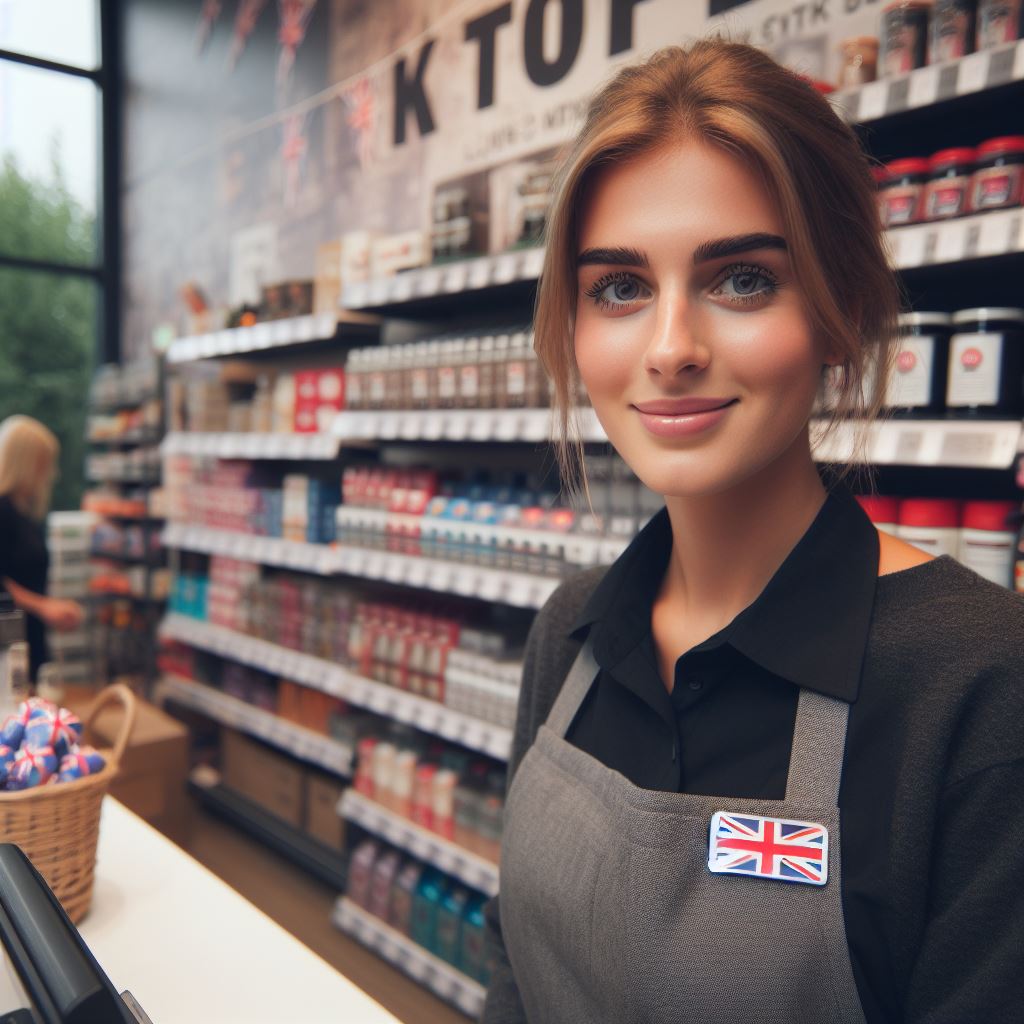Introduction
Visual Merchandising is the art of arranging products and displays in a way that enhances the shopping experience for customers.
It goes beyond simply organizing products on shelves and includes the strategic placement of displays, signage, and decorations.
By creating an aesthetically pleasing and engaging environment, Visual Merchandising aims to capture the attention of customers and influence their purchasing decisions.
In the retail industry, Visual Merchandising plays a crucial role in driving sales.
It helps retailers stand out from competitors by creating a unique and memorable brand image.
By showcasing products in an enticing manner, Visual Merchandising can increase customer interest and encourage impulse purchases.
It can help build customer loyalty by creating a pleasant and immersive shopping experience.
The purpose of this blog post is to explore the current trends in Visual Merchandising in the UK.
With the ever-evolving retail landscape, it is essential for retailers to stay updated on the latest techniques and strategies.
From interactive displays to theme-based installations, this post will provide insights into the innovative ways UK retailers are using Visual Merchandising to attract and engage customers.
Whether you are a retailer, visual merchandiser, or simply interested in the industry, this post will offer valuable information and inspiration to elevate your visual merchandising efforts.
Evolution of Visual Merchandising in the UK
Historical overview of Visual Merchandising in the UK
Visual merchandising has a long history in the UK, tracing back to the 19th century.
Initially, window displays were simple, with basic arrangements and minimal use of props or lighting.
As the retail industry grew, visual merchandising became more sophisticated and began to focus on creating unique experiences for customers.
In the early 20th century, major department stores like Selfridges and Harrods started using elaborate window displays to attract and engage customers.
Personalized UK Career Consulting
Receive tailored career guidance designed just for you. Get actionable steps and expert support to boost your career in 1-3 days. Take control of your career now.
Get StartedVisual merchandising in the UK has always been driven by creativity, innovation, and the desire to stand out in a competitive market.
During the mid-20th century, the introduction of mannequins and more intricate displays revolutionized visual merchandising.
By the late 20th century, department stores and fashion retailers in the UK started collaborating with renowned artists and designers to create visually stunning displays.
Today, visual merchandising is an essential element of the retail industry in the UK, serving as a powerful marketing tool.
Storefronts and window displays in the UK have become works of art, captivating passersby and drawing them into the store.
Influence of technology and digital platforms on Visual Merchandising practices
- Advancements in technology have greatly impacted visual merchandising practices in the UK.
- The rise of digital platforms and social media has prompted retailers to create more visually appealing displays to capture attention online.
- Interactive displays and augmented reality have become common in the UK, providing customers with immersive experiences.
- Digital signage and screens have replaced traditional static displays, allowing retailers to display dynamic and customizable content.
- Online shopping experiences have influenced in-store visual merchandising, with retailers adopting similar aesthetics and product showcasing techniques.
- Data-driven insights from online sales have helped optimize visual merchandising strategies, ensuring maximum impact and conversion rates.
Current industry trends and innovations
- In the UK, sustainability has become a significant trend in visual merchandising, with retailers using eco-friendly materials and promoting conscious consumption.
- Pop-up stores and temporary installations have gained popularity, providing retailers with opportunities to experiment with unique visual merchandising concepts.
- Personalization is another prevailing trend, with retailers using customer data to create tailored visual displays and personalized shopping experiences.
- Experiential visual merchandising has become prominent, with retailers focusing on creating memorable and interactive moments for customers.
- Integration of technology, such as touchscreens and virtual reality, allows retailers to provide interactive and engaging experiences.
- Minimalistic and clean visual merchandising displays have gained traction in the UK, emphasizing simplicity and highlighting the product itself.
- Collaborations with local artists and designers are also increasingly common, showcasing unique creative talents and supporting the local creative industry.
In fact, visual merchandising in the UK has evolved significantly over the years.
From its humble beginnings to the incorporation of technology and current industry trends, visual merchandising plays a crucial role in attracting and engaging customers.
With each passing year, the UK continues to push the boundaries of visual merchandising, creating visually stunning displays that captivate and leave a lasting impression on customers.
Read: Fashion Merchandising in the UK
Key Components of Visual Merchandising
A successful visual merchandising strategy involves various key components that work together to create an engaging and memorable shopping experience.
Window displays and their significance
- Window displays are the first impression a store creates for potential customers.
- They showcase a store’s brand identity, products, and seasonal promotions.
- Well-designed window displays can attract attention and draw customers into the store.
- They should be regularly updated to capture customers’ interest and reflect current trends.
Store layout and design
- An effective store layout considers the flow of traffic and maximizes sales opportunities.
- It should be visually appealing and guide customers seamlessly through different sections.
- Strategic placement of high-margin products and impulse-buy items can increase sales.
- Aisle width, shelving height, and signage should be carefully considered for optimal customer experience.
Use of colors, lighting, and signage
- Colors evoke specific emotions and can influence customer buying behavior.
- Lighting sets the mood and highlights products, creating a visually appealing atmosphere.
- Signage should be clear, informative, and consistent with the store’s branding.
- Effective use of colors, lighting, and signage enhances the overall visual presentation.
Product placement strategies
- Strategically placing products can influence customer purchasing decisions.
- Featured products should be eye-catching, easily accessible, and logically grouped together.
- End-cap displays and product demonstration areas can attract attention and boost sales.
- Regularly rearranging products keeps the store fresh and encourages exploration.
Interactive and experiential elements
- Interactive displays and experiences create a memorable and immersive shopping environment.
- Technology integration, such as touchscreens or virtual reality, can engage customers.
- Allowing customers to try products or participate in activities enhances their overall experience.
- Unique and interactive elements encourage customers to spend more time in the store.
In essence, visual merchandising is a crucial aspect of retail marketing that directly impacts customer perception and sales.
Window displays, store layout, colors, lighting, signage, product placement, and interactive elements all play significant roles in creating an enticing shopping experience.
By carefully considering these key components and regularly updating them to reflect current trends, retailers in the UK can effectively attract and retain customers in today’s competitive market.
Read: Merchandising Tools & Technology
Your Dream Job Starts with a Perfect CV
Get a tailored CV and cover letter that captures your unique strengths and stands out in your industry. Let us help you make an unforgettable first impression.
Get StartedPopular Visual Merchandising Trends in the UK
Minimalistic and clean aesthetics
Visual merchandising in the UK is now focused on embracing simplicity and clean aesthetics.
Retailers are using minimalistic designs to attract customers.
The use of white space, neutral colors, and simple layouts creates a calm and uncluttered shopping environment.
By reducing visual noise, retailers are able to highlight their products and create a more seamless shopping experience.
Integration of sustainable and eco-friendly concepts
In recent years, there has been a growing emphasis on sustainability and eco-friendly practices in visual merchandising.
Retailers are incorporating natural materials and recyclable packaging for their products.
Stores are using energy-efficient lighting and opting for sustainable store designs to reduce their environmental impact.
Customers are increasingly drawn to brands that prioritize sustainability, making eco-friendly visual merchandising a key trend in the UK.
Personalization and customization to enhance customer experience
To provide a unique and memorable shopping experience, retailers in the UK are focusing on personalization and customization.
By offering personalized recommendations, tailored promotions, and customized products, retailers can enhance customer satisfaction and loyalty.
In-store technology, such as interactive displays and smart mirrors, allows customers to try out different looks and styles before making a purchase.
Incorporation of digital technology and virtual reality
Digital technology and virtual reality have revolutionized visual merchandising in the UK.
Stores are using digital signage, interactive touch screens, and virtual reality experiences to engage customers and create immersive shopping environments.
Virtual reality allows customers to visualize products in their own space, making the shopping experience more convenient and personalized.
Optimize Your LinkedIn for Success
Boost your LinkedIn profile with a professional bio, keyword-rich headline, and strategic recommendations that attract recruiters. Stand out from the crowd and get noticed.
Optimize NowCollaborations and pop-up shops to create a sense of exclusivity
To create a sense of exclusivity and excitement, retailers in the UK are collaborating with other brands and hosting pop-up shops.
These collaborations allow retailers to feature limited-edition products and create unique shopping experiences.
Pop-up shops, whether temporary physical spaces or online pop-ups, generate buzz and attract customers who want to be a part of something exclusive.
In general, visual merchandising in the UK is evolving with the changing demands of consumers.
The trends mentioned above reflect the desire for simplicity, sustainability, personalization, and innovation in retail spaces.
By embracing these trends, retailers can create engaging and unforgettable shopping experiences for their customers.
Read: Success Stories: UK Merchandisers

Successful Visual Merchandising Strategies in the UK
Case studies of renowned retailers and their effective visual merchandising techniques
- John Lewis: Utilizes clean and minimalist displays to highlight product features and create an upscale atmosphere.
- Harrods: Implements extravagant window displays to captivate passersby and convey luxury.
- Selfridges: Incorporates interactive elements and immersive experiences to engage customers and create a sense of wonder.
- Primark: focuses on high volume, low-cost items, utilizing bright colors and bold displays to attract attention.
- Marks & Spencer: delivers consistent branding and uses visual storytelling to evoke emotions and connect with customers.
Analysis of consumer psychology and its influence on visual merchandising strategies
- Visual cues: Color, lighting, and arrangement impact consumer perception and influence purchasing decisions.
- Product placement: Positioning high-margin or popular items at eye level increases their chances of being sold.
- Store layout: A well-organized layout with clear pathways and easily accessible products improves customer experience and encourages exploration.
- Visual hierarchy: Using size, color, and positioning to guide customers’ attention towards key products or promotions.
- Emotional appeal: Creating an emotional connection through visuals, such as imagery that aligns with target customers’ aspirations or values.
Importance of storytelling and creating narratives through visual displays
- Creating a narrative: Telling a story through visual displays helps customers understand the brand’s values and products.
- Engaging customers: By stimulating emotions and curiosity, visual storytelling encourages customers to spend more time in-store.
- Brand differentiation: Unique visual narratives distinguish retailers from competitors and create a memorable shopping experience.
- Evoking nostalgia: Using familiar elements or references can trigger nostalgia, creating a positive association and increasing customer loyalty.
- Building brand loyalty: Consistently reinforcing the brand narrative through visual displays strengthens customer loyalty and encourages repeat visits.
Data analytics and its role in optimizing visual merchandising efforts
- Customer behavior analysis: Tracking customer movements and interactions provides insights to optimize store layouts and product placements.
- Sales analysis: Analyzing sales data in relation to visual displays helps identify the effectiveness of different strategies.
- A/B testing: Experimenting with different visuals and measuring their impact on sales allows for data-driven decision-making.
- Heat mapping: Using sensors or cameras to track customer engagement with specific areas or displays, informing layout improvements.
- Personalization: Utilizing customer data to tailor visual merchandising strategies to individual preferences, increasing customer engagement and sales.
In a nutshell, successful visual merchandising in the UK relies on a combination of effective techniques and understanding consumer psychology.
Case studies of renowned retailers demonstrate the impact of thoughtful displays, while analysis of consumer behavior highlights the importance of elements such as visual cues and emotional appeal.
Sorytelling through visual displays and leveraging data analytics optimize merchandising efforts, creating engaging experiences and driving sales.
By staying attuned to these strategies, retailers can thrive in the competitive UK market.
Read: Merchandising: Freelance vs. In-House
Challenges and Future Perspectives of Visual Merchandising in the UK
Impact of e-commerce and online shopping on traditional visual merchandising practices
- The rise of e-commerce has transformed the retail landscape and posed challenges to traditional brick-and-mortar stores.
- Visual merchandising practices that were once effective in physical stores may not translate well in the online realm.
- Customers now have access to a wide array of products and can make purchases with the click of a button, reducing the need for physical displays.
- Retailers must find innovative ways to engage customers and capture their attention in the digital space.
- Online visual merchandising involves creating compelling images and virtual displays to entice customers and encourage conversion.
- Retailers must also optimize their websites and online platforms to provide a seamless and visually appealing shopping experience.
Balancing digital and physical visual merchandising strategies
1. Finding the right balance between digital and physical visual merchandising is crucial for retailers.
2. While online shopping is convenient, many customers still value the immersive experience of visiting physical stores.
3. Retailers should integrate digital elements into their physical stores to create a cohesive and engaging environment.
4. Interactive displays, digital signage, and video content can enhance the overall visual merchandising experience.
5. Combining the tactile experience of physical stores with the convenience and personalization of online shopping can attract and retain customers.
6. It is important for retailers to create a seamless omnichannel experience where customers can seamlessly transition from online to offline and vice versa.
Opportunities for growth and revitalization of visual merchandising in the post-pandemic era
- The COVID-19 pandemic has forced retailers to adapt their visual merchandising strategies.
- With restrictions on in-store shopping and increased reliance on online channels, visual merchandising has become essential in creating a captivating online experience.
- As the world recovers from the pandemic, there is an opportunity for revitalization and growth in the field of visual merchandising.
- Retailers can leverage new technologies such as augmented reality and virtual reality to create immersive online shopping experiences.
- There is also an increased focus on sustainability and ethical practices, which can be incorporated into visual merchandising strategies.
- Retailers who prioritize creating visually stunning and sustainable displays will have a competitive advantage in the post-pandemic era.
Future trends and predictions in the field of visual merchandising
- Personalization will continue to be a key trend in visual merchandising, both online and offline.
- Artificial intelligence and data analytics will play a larger role in optimizing visual merchandising strategies.
- Virtual reality and augmented reality will become more prevalent in creating immersive shopping experiences.
- Sustainability and eco-conscious displays will continue to gain traction.
- Interactive displays and touchless technologies will become more common, providing a safer and more engaging shopping experience.
- The integration of social media and user-generated content into visual merchandising strategies will increase.
Visual merchandising in the UK faces challenges and opportunities in the ever-evolving retail landscape.
The impact of e-commerce, the need to balance digital and physical strategies, the post-pandemic revitalization, and future trends all shape the future of visual merchandising.
Explore Further: Sales Associate: Salary Trends in the UK
Conclusion
Visual merchandising trends in the UK play a crucial role in attracting and engaging customers.
Retailers must stay updated and adapt to these trends.
Visual merchandising directly impacts customer experience and influences purchasing decisions.
It helps create a unique brand identity and drives sales.
By adapting and embracing new technologies and trends, retailers can create captivating and memorable shopping experiences for their customers.
Retailers should continuously research and implement new visual merchandising techniques to stay competitive in the UK market.
Seeking inspiration and experimenting with different strategies can lead to innovation and success. Explore!




